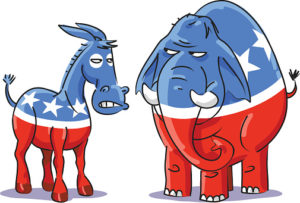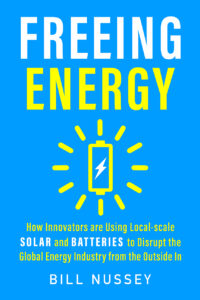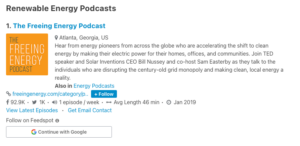
This is the second in our series. See part 1 here: Myth busting the crazy politics of clean energy: Is Solyndra proof that the US shouldn’t fund clean energy?
Myth: Republicans dislike clean energy and don’t believe in climate change
Let’s start by reviewing the Democratic party platform on clean energy and climate change.
Addressing Climate Change Responsibly
The same human economic activity that has brought freedom and opportunity to billions has also increased the amount of carbon in the atmosphere. While the scope and long-term consequences of this are the subject of ongoing scientific research, common sense dictates that the United States should take measured and reasonable steps today to reduce any impact on the environment. Those steps, if consistent with our global competitiveness will also be good for our national security, our energy independence, and our economy. Any policies should be global in nature, based on sound science and technology, and should not harm the economy.
The Solution: Technology and the Market
As part of a global climate change strategy, Republicans support technology-driven, market-based solutions that will decrease emissions, reduce excess greenhouse gases in the atmosphere, increase energy efficiency, mitigate the impact of climate change where it occurs, and maximize any ancillary benefits climate change might offer for the economy.
Oops, wait a minute, that isn’t the Democratic party platform. This was an excerpt from the Republican party platform in 2008. Silly me.

In 2008, the official Republican party platform document used the term “climate change” 13 times and “carbon” 4 times – all in the context of acknowledging the risks and recommending actions. But then something happened – four years later, Republicans did an about-face. In the 2012 Republican Party platform, “climate change” is mentioned only once and is used in quotes to highlight the misplaced priorities of the Democratic President. Carbon is not mentioned at all.
Myth: The Democrats have put massive federal subsidies in place for clean energy
Actually, the major federal clean energy subsidies were put in place during the tenure of Republican presidents.
GET MONTHLY NEWS & ANALYSIS
Unsubscribe anytime. We will never sell your email or spam you.
The federal Investment Tax Credit (ITC) is a popular political punching bag. It provides a 30% tax credit on new solar installations. The ITC was first put in place as part of the Energy Policy Act of 2005 – during the Republican presidency of George Bush. It was improved and extended in 2006 and then again in 2008 as part of the Emergency Economic Stabilization Act, also while Bush was in office.
For wind, the main federal subsidy is the Production Tax Credit (PTC). This has a much longer history. It was initially put in place in 1992, under the elder President George H. W. Bush. It was extended and renewed in the decades since. Both wind and solar subsidies were extended during Democratic President Barack Obama. Both are on schedule to wind down in the next few years.
The Freeing Energy Perspective
There is no agreement on why clean energy has become so politically divisive. One person told me that if Al Gore had been a Republican, Democrats would now be anti-clean-energy. Another person pins the political division on behind-the-scenes fossil fuel special interests that are aligned with the Republican Party. Yet another person told me that it’s just the political issue du jour. They said, give it another ten years and the parties will switch places on it.
Regardless of how we got into this political beehive, the way out is clear. In the last two years, clean energy has gained the support of the most powerful political force of all… profits. Clean energy is now the cheapest way to generate electricity in most situations. We just need to get the word out. We’ll continue to do our small part here at the Freeing Energy Project. Stay tuned for much, much more.
Additional reading
- How G.O.P. Leaders Came to View Climate Change as Fake Science (NY Times 2017)



